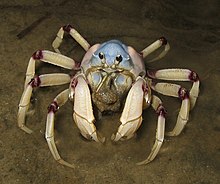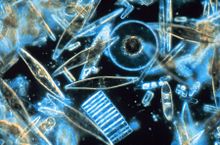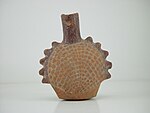Animal shell: Difference between revisions
m Date the maintenance tags or general fixes |
|||
| Line 25: | Line 25: | ||
===Other sea creatures=== |
===Other sea creatures=== |
||
[[Image:Seashells.JPG|left|thumb|200px|Seashells]] |
|||
The [[brachiopod]]s, or lamp shells, superficially resemble clams, but the phylum is completely unrelated to mollusks. Most lines of brachiopods were ended during the [[Permian-Triassic extinction event]], and their ecological niche filled by bivalves. |
The [[brachiopod]]s, or lamp shells, superficially resemble clams, but the phylum is completely unrelated to mollusks. Most lines of brachiopods were ended during the [[Permian-Triassic extinction event]], and their ecological niche filled by bivalves. |
||
[[Coral]]s are small anemone-like polyps which secrete [[aragonite]] (a form of [[calcium carbonate]]) to form a hard skeleton. The many skeletons in a colony aggregate to form [[coral reef]]s. The construction of the shell-like structures are aided by a [[symbiotic]] relationship with a class of [[algae]], [[zooxanthella]]e. |
[[Coral]]s are small anemone-like polyps which secrete [[aragonite]] (a form of [[calcium carbonate]]) to form a hard skeleton. The many skeletons in a colony aggregate to form [[coral reef]]s. The construction of the shell-like structures are aided by a [[symbiotic]] relationship with a class of [[algae]], [[zooxanthella]]e. |
||
Some [[echinoderm]]s ([[starfish]], [[sea urchin]]s, [[sand dollar]]s) and some [[polychaetes]] (annelid worms) also have hard exoskeletons. The now-extinct [[ostracoderm]]s ("shell-skins") were a type of armoured marine fish which flourished in North America and Europe during the [[Ordovician]], [[Silurian]] and [[Devonian]] geological periods. |
Some [[echinoderm]]s ([[starfish]], [[sea urchin]]s, [[sand dollar]]s) and some [[polychaetes]] (annelid worms) also have hard exoskeletons. The now-extinct [[ostracoderm]]s ("shell-skins") were a type of armoured marine fish which flourished in North America and Europe during the [[Ordovician]], [[Silurian]] and [[Devonian]] geological periods. |
||
===Arthropods=== |
===Arthropods=== |
||
Revision as of 21:09, 19 July 2008
It has been suggested that this article be merged with exoskeleton. (Discuss) Proposed since July 2008. |

A shell is a hard, rigid outer layer developed by a wide variety of different animal species, including mollusks, crustaceans, turtles and tortoises, armadillos, and microscopic organisms. Shells are used for protection, locomotion, defence, structure or in ways that relate to feeding. Scientific names for shell types include exoskeleton, armour, test, carapace, cuticle and peltidium.
The shells that are perhaps most familiar and most commonly encountered, both in the wild and as decorative objects, are seashells. These are usually primarily composed of calcium carbonate, which can take different crystalline forms, one being nacre otherwise known as mother of pearl.
Other kinds of animal shells are made from chitin, bone and cartilage, or silica.
Mollusks


Mollusks (also spelled molluscs) can thrive in the sea, in fresh water, or on land.
Marine mollusks, traditional "seashells"
The majority of shell-forming marine mollusks belong to two classes: Gastropoda (univalves, or snails) and Bivalvia (bivalves, including clams, oysters, and scallops). Smaller shell-bearing classes include Scaphopoda (tusk shells), Polyplacophora (chitons, which have eight articulating shelly plates), and Monoplacophora (single-shelled chiton-like animals). Nautiluses are the only extant cephalopods which have an external shell, although octopuses, cuttlefish and squid have small internal shells.
A mollusk shell is formed, repaired and maintained by a part of the anatomy called the mantle. Any injuries to or abnormal conditions of the mantle are usually reflected in the shape and form and even color of the shell.
Shells in other animals


A large variety of other animal taxa form exoskeletons of calcium carbonate, chitin or silica.
Other sea creatures

The brachiopods, or lamp shells, superficially resemble clams, but the phylum is completely unrelated to mollusks. Most lines of brachiopods were ended during the Permian-Triassic extinction event, and their ecological niche filled by bivalves.
Corals are small anemone-like polyps which secrete aragonite (a form of calcium carbonate) to form a hard skeleton. The many skeletons in a colony aggregate to form coral reefs. The construction of the shell-like structures are aided by a symbiotic relationship with a class of algae, zooxanthellae.
Some echinoderms (starfish, sea urchins, sand dollars) and some polychaetes (annelid worms) also have hard exoskeletons. The now-extinct ostracoderms ("shell-skins") were a type of armoured marine fish which flourished in North America and Europe during the Ordovician, Silurian and Devonian geological periods.
Arthropods
Many arthropods have a cuticle made up of sclerites, or hardened body parts, which form a stiff exoskeleton formed mostly of chitin. For mechanical strength, some crustaceans, myriapods and trilobites impregnate the cuticle with mineral salts, especially calcium carbonate, which can make up up to 40% of the cuticle.
In crustaceans, especially those of the class Malacostraca (crabs, shrimp and lobsters, for instance), the plates of the exoskeleton may be fused to form a more or less rigid carapace.
The rigid part of an insect's exoskeleton is called the procuticle; when outgrown, this construct must be shed during moulting. Arachnids (spiders, scorpions, harvestmen, ticks, and mites) have a peltidium made up of several plates which may or may not be fused. Myriapods (centipedes and millipedes) have overlapping scales of chitin, which are quite hard in some species.
Mammals
A few mammals have developed hard, shell-like armour. The shell of the armadillo is formed by plates of dermal bone covered in small, overlapping epidermal scutes. The pangolin or scaly anteater has armoured plates made up of hair, similar to the horn of the rhinoceros.
Echidna, spiny anteaters, porcupines and hedgehogs use spines of hardened keratin as a form of protection.
Reptiles
Turtles, tortoises and terrapins form a hard carapace and plastron of bone and cartilage which is developed from their ribs.
A crocodile exoskeleton is formed of bony scutes and horn-like scales.
Dinosaurs
Ankylosauria and Stegosauria are among the dinosaurs which grew thick plate-like armour on their bodies
Planktons and protists
Plant-like diatoms and animal-like radiolarians are two forms of plankton which form hard silicate shells.
Protists such as foraminifera, coccolithophores and testate amoebae create shells called "tests" of calcium carbonate.
Shells as decorative items in human culture

Throughout the history of humanity, shells of many types and from many different kinds of animals have been popular as human adornments.
Seashells are often used whole and drilled so that they can be threaded like a bead, or cut into pieces of various shapes. Shells have been formed or incorporated into pendants, beads, buttons, brooches, rings, and hair combs, among other uses. Tortoiseshell has been used for jewelry and hair combs, and for many other items as varied as inkwells, sunglasses, guitar picks, and knitting needles.
The Moche culture of ancient Peru worshipped animals and the sea and often depicted shells in their art.[1] Some tribes of the indigenous peoples of the Americas used shells for wampum and hair pipes.[2]
Small pieces of colored and iridescent shell have been used to create mosaics and inlays, which have been used to decorate walls, furniture and boxes. Large numbers of whole seashells, arranged to form patterns, have been used to decorate mirror frames, furniture and man-made grottos.
See also
- The Bailey-Matthews Shell Museum
- Seashell surface, a mathematical construct
References
- ^ Berrin, Katherine & Larco Museum. The Spirit of Ancient Peru:Treasures from the Museo Arqueológico Rafael Larco Herrera. New York: Thames and Hudson, 1997.
- ^ Ewers, John C. "Hair Pipes in Plains Indian Adornment", Bureau of American Ethnology Bulletin 164, pp. 29-85. United States Government Printing Office, Washington : 1957
